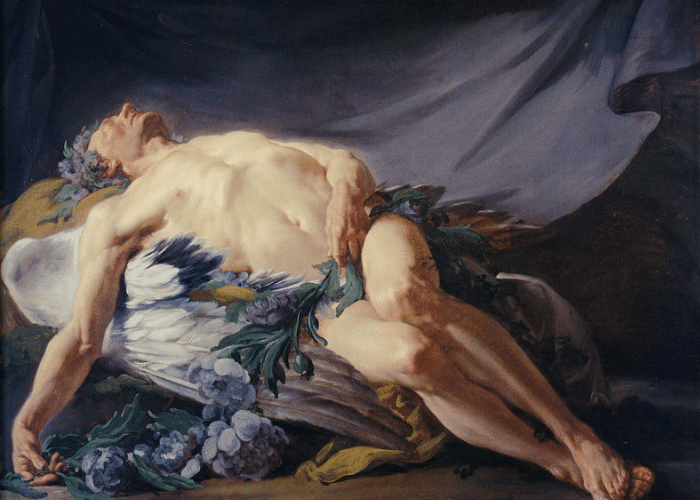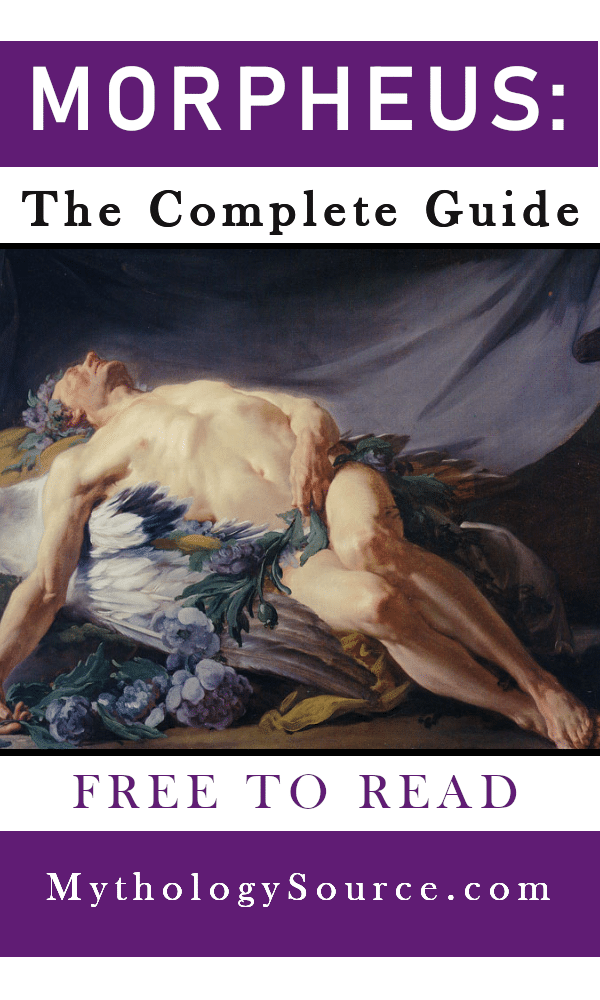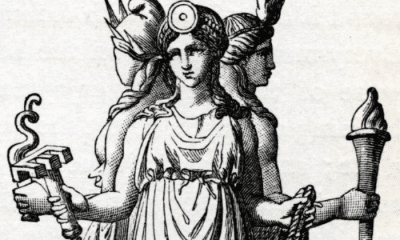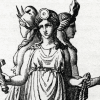
Greek
Morpheus: The Personification of Dreams
Morpheus: The Personification of Dreams
You’ve probably heard his name, now learn the real story behind Morpheus, the personification of dreams!
The mythology of ancient Greece contained many minor gods and goddesses. Most of these were daimones, the personifications of various concepts, emotions, and ideas.
Many of these spirits can be recognized by modern readers because, although they were minor gods, the words that gave them their names have been handed down to us from Greek. Harmonia was the personification of harmony, Pheme was fame, and Mania was frenzy.
One of these was Morpheus, but he was one of the rare personifications whose name did not match what he’s commonly associated with. While morphe was the word for formation, he was a spirit associated with dreams.
Morpheus was not, however, the only god of dreams in ancient Greece. He was one of a thousand spirits who carried visions, both true and false, to men as they slept.
How Morpheus got his name is not a mystery. One work from ancient literature clearly describes the daimon and his abilities.
What is a mystery, however, is whether Morpheus was a Greek deity at all.
Morpheus and the Oneiroi
Morpheus was the leader of the Oneiroi, the personifications of dreams.
Their father was Hypnos, the personified spirit of sleep. Hypnos’s mother was Nyx, the primordial goddess of the night, and his brother was Thanatos, the personification of death.
Hypnos had one thousand children. The Oneiroi were dark, winged spirits who flew forth every night to bring both true and false dreams to mankind.
Among the thousand Oneiroi, Morpheus was one of the few who was named. Share on XThe personified dreams were among many such spirits in the Greek pantheon.
While the major gods of Olympus are unique and often complex characters, the more numerous personified spirits made up the majority of the Greek deities. They represented nearly everything in the world and human experience including ideals, vices, physical attributes, and emotions.
Most of these beings, called daimones by the Greeks, shared their names with the noun they personified. Onieros was the Greek word for “dream.”
Some of these daimones became prominent characters in mythology. Eros, for example, was the personification of love.
Most, however, were minor characters who were rarely mentioned. As was the case of the Oneiroi, many of the thousands were not even given individual names.
The daimones, by and large, had few individual traits and were not well-defined characters in the myth. They were inseparable from the idea they represented and it was their only function.
Morpheus was one of the few exceptions to this and was the member of the Oneiroi given the most individualization. This is because he possessed a particular skill that, when used correctly, could be valuable to the gods.
The Gates of Horn and Ivory
The Oneiroi lived in Erebos, the land of eternal darkness that lay beyond the rising sun. Each night they flew out from their cavernous home like a thousand bats to spread dreams around the world.
As they left Erebos, each Oneiros passed through one of two gates. One gate was made of horn, the other of ivory.
The gate that each Oneiros passed through determined what type of dream it would carry on that night.
The gate of horn gave prophetic dreams that were sent by the gods and always proved true. The gate of ivory gave falsehoods that could steer men in the wrong direction.
The idea of these two gates appeared in Greek mythology as early as Homer’s Odyssey. Linguists point to a play on words, with the Greek word for “horn” sounding similar to “fulfill” and “ivory” sounding similar to “deceive.”
The gods could instruct the Oneiroi on which gate to pass through to take prophetic dreams to a specific person. In this way, they could influence mankind indirectly and give prophecies without the aid of an oracle or seer.
The image of the Oneiroi flying through gates of horn and ivory was preserved throughout antiquity, probably due to Homer’s influence on later writers.
Morpheus in Ovid
One of the later writers that was influenced by Homer was the Latin poet Ovid. His Metamorphosis, an epic work spanning fifteen books, is the only extant source of information about Morpheus.
The Oneiroi appear in Ovid’s tale of Alcyone and Ceyx. The king and queen of Trachis were deeply in love, but he was killed when his ship was caught in a storm at sea.
Unaware that Ceyx had died, Alcyone continued to pray to Hera for his safe return. Hera sent her messenger, Iris, to inform the queen of the shipwreck.
Iris did so through a dream. She went to Erebos to send one of the Oneiroi to Alcyone as she slept.
The father Somnus (Sleep) chose from among his sons, his thronging thousand sons, one who in skill excelled to imitate the human form; Morpheus his name, than whom none can present more cunningly the features, gait and speech of men, their wonted clothes and turn of phrase. He mirrors only men; another forms the beasts and birds and the long sliding snakes.
-Ovid, Metamorphoses 11. 585 ff (trans. Melville)
Morpheus assumed the shape of Ceyx to appear in Alcyone’s dream. Among all the Oneiroi, he was most skilled at taking human form.
In her dream, Morpheus appeared to Alcyone with her husband’s features but pale and dripping with water. He tells the queen not to waste her time with false hope and prayers because he has already died.
When Alcyone awoke from her dream, she was so overcome with grief that she threw herself into the sea. The gods, however, took pity on the couple and turned both Alcyone and Ceyx into kingfishers.
This account of the dream of Alcyone is the only mention of Morpheus in the ancient sources. As such, it is unclear whether he and his named brothers were already known or if their identities were invented by Ovid.
While the Roman writer typically preserved the major characters and happenings in mythology, he sometimes took poetic license with more minor details. It is very likely the that names and skills of Morpheus and his brother were created by Ovid to add detail and interest to a well-known story.
The Spirits of Sleep
Morpheus is just one of the Oneiroi named by Ovid.
Each of the spirits named in his account of the story of Alcyone and Ceyx is given a unique skill that sets them apart from their brothers.
Morpheus is highlighted because his skill is the one most useful for the given situation. His brothers, however, could have played important roles in other dreams.
- Phantasus – He was skilled in imitating inanimate objects. He appeared in dreams as rocks, trees, water, and other features of the landscape. His name meant “fantasy.”
- Icelus – This Oneiros had a particular skill for imitating birds, beasts, and snakes. His name meant “like” in Greek.
- Phobetor – Ovid gave this as an alternate name of Icelus. He claimed that the gods called this Oneiros Icelus, but humans referred to him as Phobetor, “frightener.”
- Somnus – While Ovid gave Greek names for the other spirits in his tale, the Roman writer used the Latin name for the god of sleep. In Greece he would have been known as Hypnos.
Ovid said that the three spirits he gave names to were those specifically assigned to bring dreams to kings and leaders. The rest of the one thousand Oneiroi visited the common people.
While the names and functions of the individual Oneiroi may have been invented by Ovid for poetic appeal, some historians believe that a division of functions or types of dreams may have Hellenistic roots. Unfortunately, any texts that would clarify the identities of the Oneiroi earlier in Greece have been lost.
The Evolution of Morpheus
Morpheus was distinguished among his brethren for his ability to imitate human form. He was able to not only duplicate the physical form of a person, but also their mannerisms and voice.
His name references this ability. Morpheus is generally translated as “fashioner.” It comes from the word morphe, “to shape,” which is the root of English words like morph and metamorphosis.
After Ovid’s time, the character of Morpheus grew in the popular imagination. As one of the ancient writers whose words remained popular in the medieval period, Ovid had a major influence in how people in the Christian world viewed mythology.
As the most prominent named daimon in Ovid’s tale, Morpheus was interpreted as the leader of his brethren. Rather than just the most skilled for the task at hand, he was seen as the head of all the Oneiroi.
By the Middle Ages, the name Morpheus was used generally to refer to dreams of all sorts. Share on XThe Greeks very likely had no concept of a god called Morpheus, or if they did he was a very minor personification. But later Europeans imagined him as the god of all dreams.
A book from the 17th century illustrates the inflated role of Morpheus in later ideas of Greco-Roman mythology. He is described as carrying a box made of horn and ivory that held both good and bad dreams.
While some elements of the original mythology remained, the character’s evolution did not end with the decline of paganism. From one of a thousand nameless spirits, a single story in Ovid’s epic work had led to Morpheus being reimagined as the creator of all dreams.
The Sandman
This evolution continues to this day.
The most famous continuation of Morpheus as a character has occurred in comic books. Neil Gaiman’s award-winning Sandman series features Morpheus as the central character.
Gaiman’s Morpheus draws on the later conception of him as the master of all dreams. In the comics he is one of the Endless, seven personifications of primordial, eternal forces of nature.
Morpheus, or Dream as he’s often called in the books, rules over The Dreaming, the realm from which all dreams and nightmares come.
The character draws not only from the Oneiros of Greek mythology, but also from the original meaning of the name. While often appearing as a tall, gaunt man dressed in black, he morphs his form at times to suit the time and place he appears in.
This character influenced another by the same name. Morpheus is one of the central characters in The Matrix film trilogy, bringing the idea of dreaming is put into a science fiction setting.
This Morpheus presents the protagonist with the choice between remaining in the artificial “dream” created by computers or to wake up and discover the truth. Just as the mythological Oneiros could present both truth and falsehood in dreams, The Matrix’s Morpheus gives a choice between the two.
The connection between Morpheus and a dream state appears in another, perhaps unexpected, place in the modern world. The drug morphine was named after the god for the state it produces in patients.
The Mystery of Morpheus
As a spirit of dreams, Morpheus has captured the imagination of writers for millennia. He represents a state of imagination.
While Morpheus has entered the popular imagination as a god of the Greek world, however, it remains unclear whether the Greeks had any concept of him at all.
Only being named in one source from Rome, there is no evidence that the Greeks recognized Morpheus as a character. It is just as likely that he came from Ovid’s vivid imagination and the Greeks gave no names to the many spirits that visited their sleep.
Whether Ovid came up with the character himself or not, he introduced Morpheus to Western literature. Share on XIn many ways, the unclear origins and changing functions of Morpheus are very much in keeping with the way Greek mythology grew and developed.
The stories were not static. They changed over time, with characters and settings gradually shifting to meet the ideas and customers of different times and places.
Like many of the more well-documented gods and goddesses, the character of Morpheus has undergone a radical evolution since his first mention in mythology. From an anonymous spirit, he has grown into the lord of dreams, the master of a realm, and a futuristic hero.




